Raspberry seeds create the perfect natural exfoliant in homemade soap, delivering gentle yet effective skin renewal. You'll want to add 1-2 teaspoons per pound of soap at trace for even distribution. Use whole seeds for stronger exfoliation or ground seeds for sensitive skin. Pair with soothing essential oils like lavender or geranium for added benefits. After 4-6 weeks of proper curing, your sustainable scrub bar will reveal smoother, healthier skin with every wash.
What Makes Raspberry Seeds the Perfect Natural Exfoliant

Nature's tiny powerhouses, raspberry seeds offer exceptional exfoliation benefits that set them apart from other natural scrubs. Their naturally abrasive texture effectively removes dead skin cells while thoroughly cleansing your pores to diminish blackheads and whiteheads.
You'll notice improved skin texture and radiance after incorporating these seeds into your skincare routine. Unlike synthetic alternatives, raspberry seeds contain beneficial antioxidants that protect your skin from free radicals while exfoliating.
What's particularly impressive is that these seeds aren't just effective—they're sustainable too. They're typically upcycled from the juice and jam industry, transforming what would be waste into a valuable skincare ingredient. These versatile exfoliants can be easily incorporated into formulations ranging from cleansers to body polishes.
When used properly (once or twice weekly), they deliver powerful exfoliation without irritating your skin, making them perfect for homemade soap scrubs.
Harvesting and Preparing Raspberry Seeds for Soap Making
You'll need fresh, ripe raspberries to extract seeds, which can be crushed and washed to separate them from the pulp.
After collection, thoroughly dry your seeds on a paper towel or in a food dehydrator to prevent mold during storage.
Consider using whole seeds for stronger exfoliation or grinding them slightly for a gentler effect in your soap bars. These natural exfoliants add visual interest to your handmade soap while providing gentle skin polishing benefits.
Seed Collection Methods
While many soap makers purchase pre-dried seeds, harvesting your own raspberry seeds offers a cost-effective and rewarding alternative.
Look for raspberries with vibrant green leaves during summer and early autumn, when they're at peak ripeness.
Hand-pick the berries carefully to protect the seeds inside. To extract the seeds, gently crush the berries and strain them through a fine mesh sieve, separating seeds from pulp.
Rinse thoroughly under cold water to remove residue and natural oils that could affect your soap's consistency.
For temporary storage before drying, keep your freshly harvested seeds in an airtight container in the refrigerator—they'll stay fresh for about a week.
This cold storage prevents mold development and preserves seed quality until you're ready for the drying process. The seeds work perfectly as an exfoliant ingredient when incorporated into your Stevenson clear melt and pour soap recipe.
Drying and Storage
Properly drying your freshly harvested raspberry seeds is essential before incorporating them into soap recipes. You'll find several effective methods: air dry naturally to preserve seed quality, use a low-temperature oven to expedite the process, or employ a food dehydrator for controlled drying.
For a cost-effective approach, try sun drying with a protective cover to prevent dust contamination.
Once dried, store your seeds in airtight containers in a cool, dark place. This prevents moisture exposure that could make them rancid and extends their shelf life up to a year.
Before adding them to your soap formulations, clean and sterilize the seeds thoroughly to remove debris and prevent contamination. Regularly check your stored seeds for signs of spoilage and maintain consistent temperature and humidity levels to preserve their exfoliating properties. When ready to use in soap, remember that raspberry seeds are known for being more abrasive than other natural exfoliants, so adjust quantities accordingly.
Grinding vs. Whole
When incorporating raspberry seeds into your handmade soaps, deciding between ground or whole seeds creates entirely different exfoliation experiences.
Grinding your seeds produces a milder scrub perfect for sensitive skin, while whole seeds deliver a more abrasive effect ideal for scrub bars.
Ground seeds distribute more evenly throughout your soap and can be added at the trace stage in cold process recipes. Similar to how evaluation results from different models are analyzed for performance, testing various grinding techniques can help determine optimal exfoliation levels.
In contrast, whole seeds often float to the surface, creating unique visual patterns and a coarser scrubbing texture.
- Texture choice: Ground = gentle exfoliation; Whole = intensive scrubbing
- Distribution: Ground seeds blend evenly; whole seeds create focal points
- Application timing: Grind seeds just before use to preserve potency
- Ratio recommendation: Use 1-2 teaspoons per pound of soap base
- Visual impact: Whole seeds offer more dramatic appearance in clear soaps
The Science Behind Raspberry Seed Exfoliation
Understanding how raspberry seeds work on your skin reveals why they've become a cherished ingredient in natural skincare. When you massage these seeds against your skin, their unique texture gently removes dead cells without the harshness of traditional exfoliants like salt or sugar.
The magic happens on two levels: physical and biochemical. As you exfoliate, the seeds stimulate circulation while clearing pores, which enhances your skin's ability to absorb moisturizing compounds.
The gentle abrasion of raspberry seeds awakens skin through dual pathways—clearing away debris while activating your skin's natural receptivity to nourishment.
Simultaneously, the seeds release essential fatty acids (omega-3, 6, and 9) that reinforce your skin's hydrolipidic film—your natural moisture barrier. These small but mighty exfoliants maintain a consistent abrasiveness rating of 2.5, making them reliable for various skin types.
What makes raspberry seeds exceptional is their dual-action approach. While they physically renew your skin's surface, their potent antioxidants protect against free radicals, supporting your skin's natural renewal cycle.
Step-By-Step Guide to Incorporating Seeds Into Your Soap Base
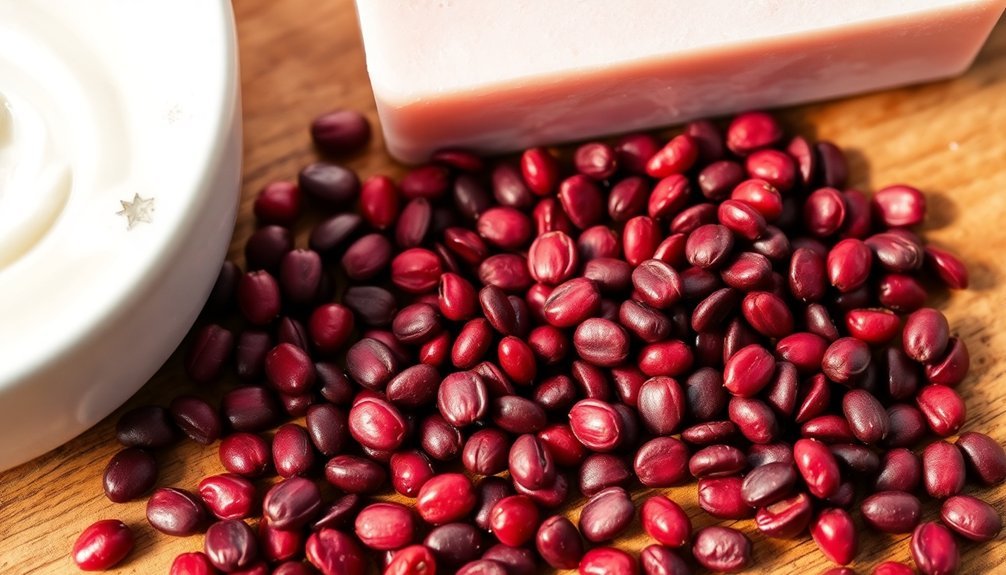
The transformation of ordinary soap into a luxurious exfoliating treatment begins with properly integrating raspberry seeds into your soap base.
Add seeds at trace stage—when your soap mixture reaches a pudding-like consistency—to guarantee even distribution. For peak scrubbing effect, use 1-2 teaspoons of seeds per pound of soap.
- Choose between whole seeds for intense exfoliation or ground seeds for gentler cleansing
- Consider raspberry seed oil as a super fatting agent to enhance moisturizing properties
- Wear protective gear (gloves, goggles) when handling lye and oils
- Work in a well-ventilated space to avoid inhaling fumes
- Allow soap to cure for six weeks to fully develop its properties and mellow its pH
Unlike annatto seeds which provide color, raspberry seeds may cause a scratchy texture in your final soap product, so adjust quantities accordingly.
Finding the Right Texture: Whole vs. Ground Raspberry Seeds
Selecting the perfect raspberry seed texture can greatly impact your soap's exfoliating properties and overall user experience.
Whole seeds provide a more intense scrubbing action with beautiful visual appeal, making them ideal for dedicated scrub bars where you want noticeable exfoliation.
Ground seeds offer a gentler alternative that's perfect for sensitive skin or daily use. They distribute more evenly throughout your soap and create a smoother, more refined sensation. At 1-2 teaspoons per pound of soap, either option delivers effective exfoliation without the harshness of walnut shells or pumice.
For optimal results, aim to use 2-4 teaspoons of raspberry seeds per pound of soap, similar to other fruit seed exfoliants.
Consider your target user when choosing: whole seeds for those wanting visible exfoliation and decorative appeal, ground seeds for those preferring subtlety and everyday gentle cleansing.
Balancing Exfoliation Power and Skin Sensitivity
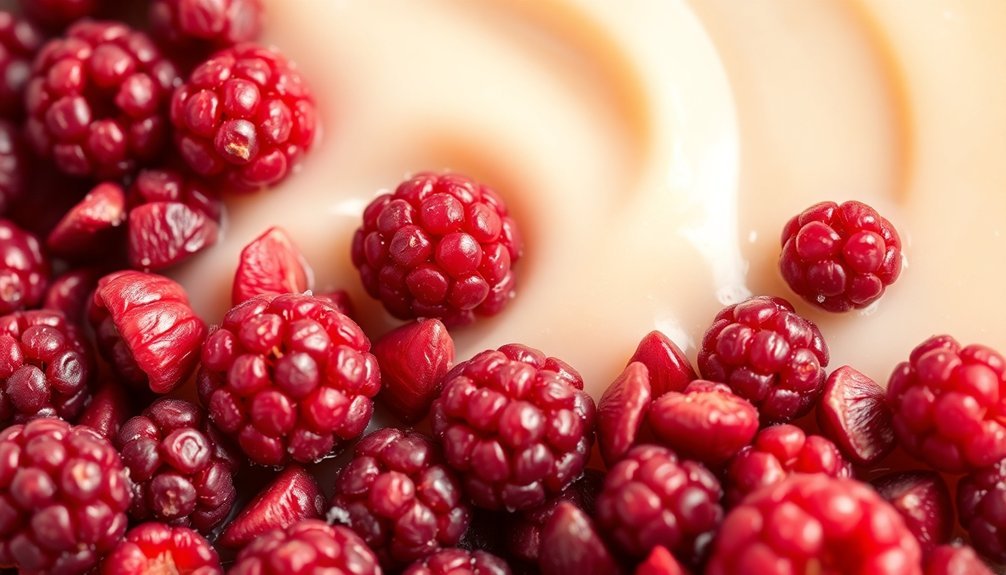
While raspberry seeds offer excellent natural exfoliation, finding the perfect balance between effective scrubbing and skin comfort is essential for creating a truly beneficial soap.
When properly ground, these seeds deliver a gentle yet effective experience suitable for most skin types. You'll need to reflect on your own sensitivity levels when crafting your perfect scrub. These seeds are particularly effective at unclogging pores and reducing blackheads when incorporated into soap formulations.
- Test raspberry seeds on a small patch of skin before full application
- Pair with soothing ingredients like aloe or chamomile for sensitive skin
- Adjust the quantity of seeds based on your exfoliation preference
- Ground seeds provide milder exfoliation than whole seeds
- Contemplate combining with other natural exfoliants for customized intensity
Remember that what works for someone else mightn't work for you—skin sensitivity varies widely, so personalization is key.
Essential Oil Pairings That Complement Raspberry Seed Soap
Choosing the right essential oil blend for your raspberry seed soap can dramatically enhance both its scent profile and therapeutic benefits.
You'll find that floral harmonies like geranium and lavender complement the fruity base, while citrus awakening blends of orange or red mandarin add a revitalizing brightness to your creation.
For a more sophisticated soap experience, consider adding earthy grounding notes such as frankincense or patchouli that balance the sweet raspberry undertones while providing additional skin benefits. Jasmine absolute offers a luxurious aromatic dimension when paired with raspberry seeds, delivering rich nourishing properties similar to its use in antioxidant skin nectars.
Floral Harmony Combinations
Perfect essential oil pairings can transform your raspberry seed soap from simply exfoliating to a luxurious sensory experience.
Floral essential oils like rose and lavender offer gentle, soothing scents that beautifully complement the natural exfoliation properties of raspberry seeds in your handcrafted soaps.
- Lavender and Chamomile Blend (40%/30%) with jasmine and bergamot creates a comforting, soothing aroma
- Rose and Ylang-Ylang (30%/40%) combined with vetiver and cedarwood produces a romantic, alluring scent
- Geranium and Lavender pairs wonderfully with citrus oils for a fresh floral experience
- Chamomile and Clary Sage delivers a calming, natural herbal-floral combination
- Lemongrass and Lavender brings an uplifting herbal zing to lavender's floral calmness
Remember to use 10-40 drops of essential oil per 100g of soap base for ideal aromatic results. For safety and effectiveness, always calculate your essential oil amounts by weight, ensuring they fall within recommended usage rates for cold process soap making.
Citrus Awakening Blends
Citrus essential oils create a revitalizing counterpoint to the gentle exfoliation of raspberry seeds in handcrafted soaps.
These bright, uplifting aromas transform your raspberry seed scrub from merely functional to sensationally energizing.
For energy-boosting combinations, try the Citrus Burst blend of equal parts lemon, lime, and orange.
You'll find Sweet Orange paired with Litsea Cubeba offers extended longevity while maintaining that sunny citrus profile.
For more complex scents, combine citrus with complementary elements—peppermint with lemon delivers a rejuvenating twist, while bergamot and cedarwood (3:2 ratio) creates sophisticated depth.
Orange and vanilla (2:1 ratio) adds delightful sweetness to your scrub bar.
Cost-conscious soapmakers will appreciate that lemon and orange oils remain affordable and widely available, making citrus blends practical for regular production. Consider using folded lemon oil for better scent retention in your raspberry seed soap bars.
Earthy Grounding Notes
While citrus notes enliven the senses, earthy essential oils anchor your raspberry seed soap with deep, comforting aromas.
These grounding scents complement raspberry's natural properties, creating a balanced experience that nourishes both skin and spirit. The soap's use of cold process method ensures these essential oil aromas remain potent and true throughout the life of the bar.
Try pairing your raspberry seed soap with these earthy essential oils:
- Frankincense – Adds calming properties that enhance relaxation while supporting raspberry's skin benefits
- Cedarwood – Provides fresh woody undertones that ground the fruity raspberry aroma
- Sandalwood – Creates rich depth that balances and harmonizes with raspberry's sweetness
- Patchouli – Offers stress-relieving qualities while adding an earthy base note
- Clary Sage – Brings herbal sweetness that complements raspberry while promoting well-being
For best results, start with equal parts and adjust to your preference, testing small batches before creating larger quantities.
Color Enhancement Techniques With Natural Raspberry Pigments
Several natural methods exist for achieving authentic raspberry tones in your homemade soap scrubs.
While actual raspberry pigments aren't common in soap making, you can create similar vibrant hues using alternative natural colorants.
For that perfect raspberry pink, try infusing your base oils with madder root, which provides lovely pink shades.
Beet juice offers a natural berry pink color that beautifully mimics raspberry tones.
For deeper red variations, consider red iron oxide as a stable alternative.
Temperature control is vital—add your chosen colorants at trace to maintain color consistency.
Test in small batches first to guarantee you achieve your desired shade.
Remember that natural colorants may change slightly over time due to oxidation, giving your soap an authentic, evolving appearance that synthetic colorants simply can't match.
For enhanced color vibrancy in your madder root soaps, consider using the gel phase technique by insulating your soap or using oven processing during saponification.
Curing and Storing Your Raspberry Seed Soap for Maximum Benefits
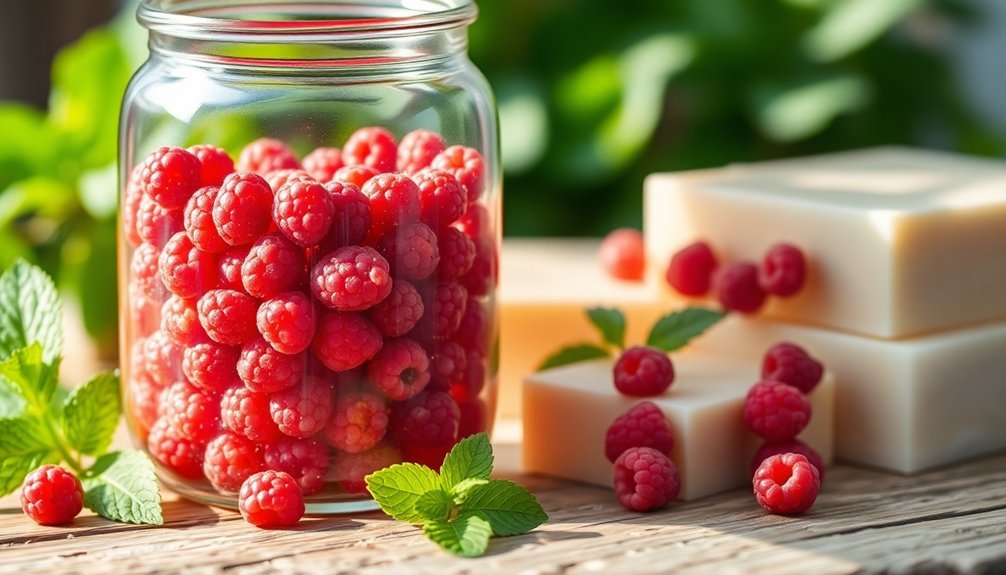
After perfecting your naturally colored raspberry-infused soap, the next phase of your soap-making journey begins. Your bars need 4-6 weeks of curing time in a well-ventilated area to become milder and longer-lasting. This essential step allows water to evaporate, reducing harshness and potential skin irritation. This curing process is particularly important for this recipe due to its high olive oil content, which is why a water discount of approximately 30.6% is recommended.
- Store cured soaps in a cool, dry place away from direct sunlight
- Avoid plastic wrapping which traps moisture—use paper or cloth instead
- Keep soap in well-ventilated areas to prevent mold growth
- Label your soaps with ingredients and production dates
- Handle with proper safety equipment (gloves, goggles) during the making process
Proper curing and storage preserves the antioxidants and fatty acids in your raspberry seed soap, maximizing its skin-nourishing benefits while extending its shelf life.
Seasonal Variations: Adapting Your Recipe Throughout the Year
Just as nature changes with the seasons, your raspberry seed soap recipe can evolve throughout the year to address shifting skincare needs and incorporate seasonal ingredients.
In spring, refresh your soap with lemon and lavender scents, or add chamomile for enhanced healing properties.
Summer calls for lighter oils like coconut, complemented by cooling citrus essential oils and vibrant colors from natural pigments.
As autumn arrives, shift to earthy tones and nourishing ingredients that protect against cooler weather. Maintaining a 10% superfat level provides excellent moisturizing properties for skin exposed to harsh autumn winds.
Winter recipes benefit from increased moisturizing agents like shea and cocoa butter to combat dry skin.
Consider seasonal packaging that reflects holiday themes or natural elements—limited edition designs can generate excitement and make perfect seasonal gifts.
Your soap's adaptability is one of its greatest strengths!
Sustainable Sourcing of Raspberry Seeds for Artisanal Soap Makers
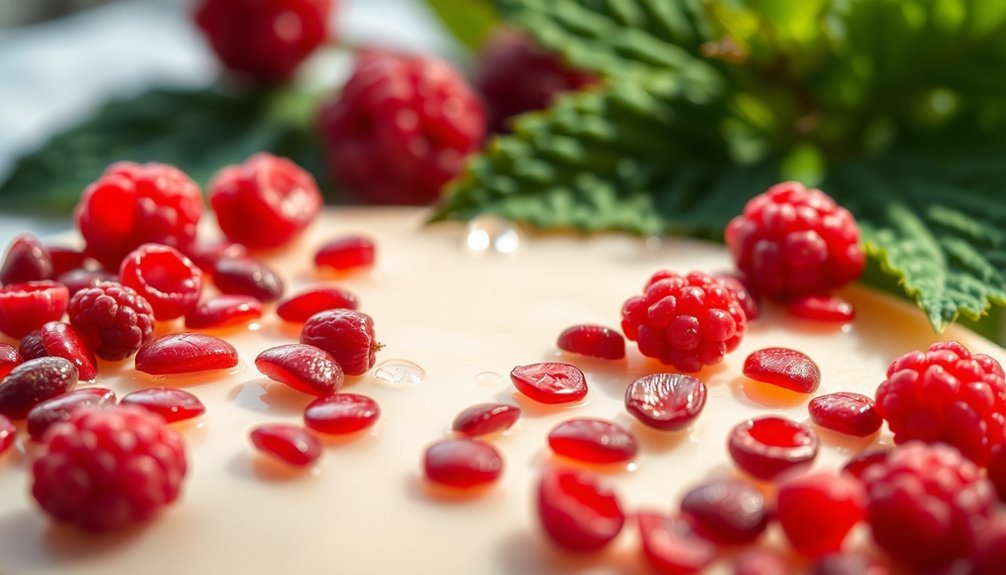
Finding ethically sourced raspberry seeds transforms both your soap's quality and its environmental impact. Look for suppliers who collect seeds as a by-product from organic ice cream or jam production to reduce waste. The Ganders farm soap recipe uses raspberry seeds and pulp from ice cream production, demonstrating this sustainable approach while creating an effective natural exfoliant.
Building relationships with local raspberry farmers guarantees freshness while supporting small businesses in your community.
Consider these sustainable sourcing strategies:
- Partner with organic farms that avoid chemical pesticides
- Source from ice cream manufacturers who'd otherwise discard seeds
- Join cooperatives that connect soap makers with ethical suppliers
- Choose suppliers with transparent supply chain practices
- Invest in cold-pressed raspberry seed oil for premium soap formulations
While sustainable sourcing may increase your costs initially, the environmental benefits and customer loyalty you'll gain make it worthwhile for your artisanal soap business.
Customer Testimonials: The Real-World Impact of Raspberry Seed Soap
The real power of raspberry seed soap emerges through the words of actual users. Customers consistently highlight the gentle exfoliation, moisturizing effects, and invigorating scent that makes these soaps a bathroom staple. The Black Raspberry Goat Milk Soap delivers a rich creamy lather that enhances the overall bathing experience.
| Benefit | Customer Quote | Skin Type |
|---|---|---|
| Exfoliation | "The seeds provide perfect gentle scrubbing" | All types |
| Moisture | "My skin feels soft without being greasy" | Dry/Normal |
| Fragrance | "Fresh berry scent that isn't overwhelming" | Sensitive |
| Anti-inflammatory | "Reduced my skin's redness within weeks" | Irritated/Sensitive |
| Sustainability | "Love that I'm using all-natural ingredients" | All types |
You'll find that raspberry seed soaps combine well with ingredients like shea butter and essential oils for enhanced benefits. They're particularly effective for those seeking sustainable skincare options that don't compromise on performance or sensory experience.
Frequently Asked Questions
How Long Does Raspberry Seed Soap Maintain Its Exfoliating Properties?
Your raspberry seed soap maintains its exfoliating properties for up to a year when stored properly in cool, dry conditions. You'll notice better longevity if you've kept it away from humidity and moisture.
Can Raspberry Seed Soap Be Used on Sensitive Facial Skin?
Yes, you can use raspberry seed oil on sensitive facial skin. It's noncomedogenic, reduces inflammation, and moisturizes without clogging pores. Always do a patch test first if you have extremely sensitive skin.
Are Raspberry Seeds Biodegradable When Washed Down the Drain?
Yes, raspberry seeds are biodegradable when washed down the drain. You'll be pleased to know they naturally decompose over time, unlike plastic microbeads, making them an environmentally responsible choice for your exfoliating products.
How Do Raspberry Seeds Compare to Microbeads in Environmental Impact?
Unlike harmful microbeads that persist in ecosystems, your raspberry seeds biodegrade naturally. You're making an eco-friendly choice as they won't accumulate toxins, harm marine life, or contaminate soil when washed down drains.
Can I Harvest Seeds From Store-Bought Raspberries for Soapmaking?
Yes, you can harvest seeds from store-bought raspberries, but they may be less effective due to processing. You'll get better results from craft suppliers who offer seeds specifically prepared for soapmaking purposes.
In Summary
You're now equipped to transform ordinary soap into luxurious exfoliating bars with raspberry seeds. Whether you're grinding them for gentle cleansing or using them whole for deeper exfoliation, you'll notice the difference in your skin's texture and glow. Don't forget to source your seeds sustainably and experiment with seasonal variations. Your homemade raspberry seed soap isn't just natural skincare—it's a daily ritual worth savoring.

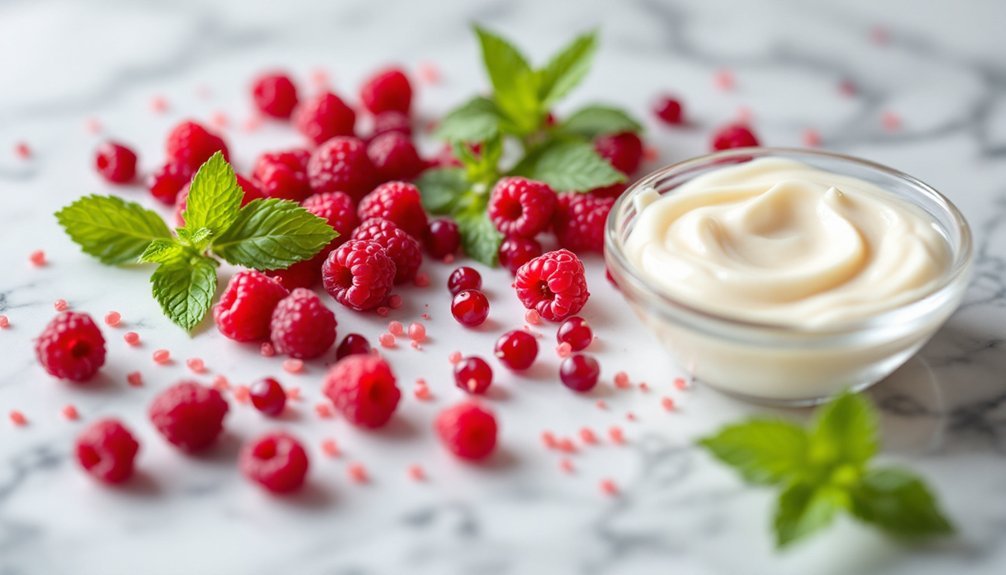



Leave a Reply